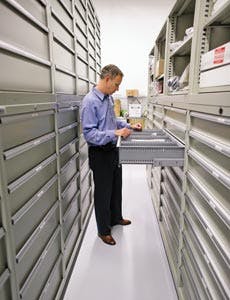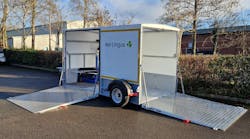By John Alfieri
The time has come to make a decision about your storage capabilities. While you have many options, one decision you may face is whether to go with drawer storage cabinets or traditional shelving. Although there are items that are well served by industrial shelves, for most items, and under most circumstances, drawer storage cabinets can provide effective storage capabilities.
A case for full cubic space
It’s likely that there are limitations to the amount of space you can devote to storage at your maintenance facility, so you certainly want to make the most of the space you do have. The fact is, drawer storage cabinets are much better at making full use of your available cubic space than shelves, particularly if you are storing small-to-medium size items of irregular shape and size.
Shelving is suitable for big, bulky, regularly shaped items — items larger than a shoebox. For example, stackable rectangular boxes can often be a nice fit for shelf space. Irregularly shaped boxes, or items with irregular surfaces (such as most instruments), can not always be easily stacked. Even if those items are stacked, cubic space is almost always wasted. Even if employees could use the full cubic air space available with shelving, most people simply don’t. Moreover, it is human nature to typically store popular items along the front edge of the shelf, hiding and inhibiting access to items at the back of the shelf.
Drawer cabinets, on the other hand, allow storage in right-height drawers which can be filled to the top, using all available cubic space. When considering drawer storage cabinets, be sure to look for drawers which feature full-height sidewalls. This, in conjunction with drawers having full-extension capabilities, means that the entire three-dimensional drawer space can be accessed — front-to-back, side-to-side, and top-to-bottom. When this style of storage is used for small to medium items, one eye-level modular drawer cabinet can hold as much as three to four sections of shelving.
The upshot of the full use of cubic space with high-density modular drawer storage is a maximized use of overall available floor space. Consider what your company is paying for every square foot of storage space. Since three to four shelf units have about the same storage capacity as one cabinet, a switch to drawer cabinet storage could reduce needed square footage by as much as 100 to 400 percent.
Case study: Corporate Jet Support
Corporate Jet Support (CJS) of Moonachie, NJ, is a leading wholesale supplier of Gulfstream aircraft parts. Recently the company’s growth was creating a problem in its storage warehouse.
Simply put, says CJS owner, Chris Breitweiser, “We ran out of room. We had grown out of our existing storage space and were forced to contemplate either moving or expanding our warehouse through expensive construction.”
The problem, as it turned out, was not one of insufficient storage space — the available 10,000 square feet was more than adequate. The problem was a storage system that was not making the best use of the available space. CJS was relying on conventional shelving and pallets to store its wide range of fast-moving aircraft parts.
CJS and Breitweiser purchased a full squadron of 250 shallow depth HS modular drawer storage cabinets from Lista, as well as two Lista Storage Wall Systems. CJS captured 10 feet of vertical space by stacking two high density HS cabinets atop each other. The HS drawer interiors were configured with flexible, modular dividing and partitioning accessories to accommodate the items CJS would be storing — everything from small washers to valves, generators, and actuators.
Explains Breitweiser, “We were able to maximize the use of our warehouse height and maintain the flexibility to put thousands of items in a very limited area. We can now hold in one drawer what we previously were storing in three units of conventional shelving.”
Order in the drawers
Drawer interiors, with their easily customizable compartments, are well suited for storing small loose items like nuts, bolts, washers, spark plugs, electrical components, and small instruments. Drawer compartments protect the items stored within them; can precisely match stored items by height, width, and depth; are easily bar code labeled; and provide direct access and viewing.
On the other hand, the industry standard way of storing these smaller items on shelves is to use a shelving bin, plastic box, or even open or semi-open cardboard boxes.
The boxes and bins are impractical in terms of seeing and accessing items that are stored. The standard industrial shelf is typically 87 inches high, with the top one or two shelves situated above a standing individual’s head. Therefore, seeing what is stored in the upper shelves is impossible without a ladder. Accessing these items is at best difficult, and at worst, dangerous — the previously mentioned semi-opened cardboard boxes can easily spill their contents from a precarious upper shelf perch.
There are some ergonomic advantages for employees working with modular drawer storage. Just as there is no reaching high for items on upper shelves, access to items stored near the floor is also much improved. When items are stored on the bottom shelf of a shelving unit, employees can find themselves on their hands and knees, awkwardly reaching for items and potentially straining backs and shoulders. With full extension drawers, all items in all drawers are within easy reach.
Inventory management
When you can easily see your inventory right in front of you, inventorying items becomes a much easier and more accurate task. On shelves, items can get moved around, shifting away from assigned homes. Items are also more likely to get lost on shelves, which leads to wasted inventory and/or stock-outs. Within an organized modular drawer, each individual item has its own compartment and items are less likely to get lost or mis-identified. Also, as items can be viewed from the front of the drawer to the farthest back corners, visual accounting is easy.
For added organization and easier inventory management, some manufacturers’ drawers have built-in label holders, and each compartment can be labeled.
Improved protection and security
Modular drawer storage cabinets protect your valuable tools, parts and other assets from environmental wear and tear. Items come out of the drawer cleaner than items stored on shelving, which can collect coatings of dirt, dust, and grime.
Drawer storage can also provide greater security for valuable items. Whereas shelving is open and unlockable by nature, cabinets are available with a range of locking options. Even within a locked storage room, additional locking systems on drawers can improve security and reduce shrinkage.
When considering storage solutions for your maintenance facility, remember that traditional shelf storage and drawer storage units offer different capabilities. Get the most out of your available space by implementing the storage solution that best fits your storage needs. AMT
John Alfieri is vice president, sales and marketing for Lista International Corp.




